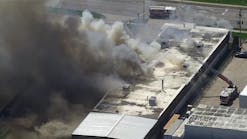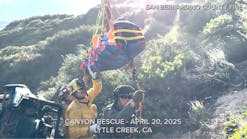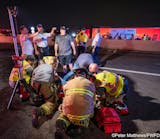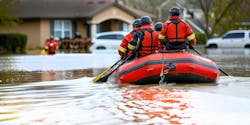Spontaneous combustion, according to the Handbook of Fire Prevention Engineering, "is a runaway temperature rise in a body of combustible material that results from heat being generated by some process taking place within the body." Spontaneous combustion may be rapid or slow. It can result from reactions of a susceptible material with air or water or from a chemical reaction. Materials involved can be chemicals, elements, or hydrocarbon compounds or a mixture.
Slow spontaneous combustion can occur in two general ways: biological processes of some microorganisms and slow oxidation. Biological processes occur within organic materials such as hay and grass clippings. The activity of biological organisms within the material generates heat that is confined by the materials themselves until the ignition temperature is reached and ignition occurs.
Slow oxidation is a chemical reaction. Chemical reactions may produce heat; reactions that produce heat are considered exothermic. If the heat is insulated from dissipating to the outside of the material, it will continue to build up. As the heat builds, the material is heated from within. The process continues until the ignition temperature of the material is reached and ignition occurs.
Hydrocarbon compounds usually undergo slow spontaneous combustion. Generally, hydrocarbon compounds are considered saturated or unsaturated. Within saturated compounds, all of the chemical bonds among the elements in the compound are single. Single bonds are "full," for there isn't room or a method for another element to attach. Double or triple bonds are unsaturated. In other words, the double bond can break, and when it does, another element can attach. Spontaneous ignition occurs when this double or triple bond breaks and creates heat and the heat is confined. The material itself produces heat sufficient to reach its own ignition temperature.
Some materials subject to spontaneous combustion are not considered hazardous in transit by the U.S. Department of Transportation (DOT) and may not be placarded or labeled. Materials may have other hazards considered more severe. DOT has assigned a hazard class to materials that are shipped in transportation and subject to spontaneous combustion by chemical nature. Flammable solids, Class 4.2 materials are spontaneously combustible. The DOT defines them as pyrophoric materials.
Even though this hazard class is flammable solids, these materials may be found as solids or liquids. They can ignite without an external ignition source within five minutes after coming into contact with air. There are other 4.2 materials that may be self-heating, i.e., in contact with air and without an energy supply (ignition source); they are liable to self-heat, which can result in a fire involving the material or other combustibles nearby. This type of spontaneous combustion is considered rapid.
Materials can also spontaneously combust when in contact with water. When some carbon-based materials, such as activated carbon or charcoal briquettes, are in contact with water, an oxidation reaction occurs between the carbon material, the water, and pockets of trapped air. This type of spontaneous combustion occurs slowly. The reaction is exothermic, which means heat is produced in the reaction and slowly builds up until ignition occurs spontaneously. Because the reaction is so slow, we use charcoal lighter rather than water when we are cooking on the grill!
Materials subject to spontaneous heating are listed below:
- Alfalfa meal
- Animal hides
- Castor oil
- Charcoal
- Coal
- Cottonseed oil
- Fertilizers
- Fish meal
- Fish oil
- Lanolin
- Lard oil
- Linseed oil
- Manure
- Metal powders
- Olive oil
- Peanut oil
- Powdered eggs
- Soybean oil
- Used burlap
- Whale oil
Some types of combustible liquids, such as animal and vegetable oils, have a hidden hazard: they may burn spontaneously when improperly handled. They have high boiling and flash points, narrow flammable ranges and low ignition temperatures, and are non polar. Carbon-based animal or vegetable oils, such as linseed oil, cooking oil, cottonseed oil, corn oil, soybean oil, lard and margarine, can undergo spontaneous combustion when in contact with rags, cardboard, paper or other combustibles. These unsaturated compounds can be dangerous when combustible materials containing residue are not properly disposed of or they come in contact with other combustible materials.
There is a double bond in the chemical make-up of animal and vegetable oils that reacts with oxygen in the air. The oxygen from the air trapped in the mass reacts with the double bonds present in the animal and vegetable oils. The breaking of the double bonds creates heat. If the heat is allowed to build up in a pile of rags, for example, spontaneous combustion will occur over a period of hours. Fires started by this spontaneous heating process can be difficult to extinguish because they usually involve deep-seated fires. In order for enough heat to be sustained to cause combustion, there must be insulation. This insulation can be the material itself or may be in the form of some other combustible material.
Spontaneous heating cannot occur in the case of petroleum oils or other hydrocarbon materials that are saturated. Ordinary petroleum products, such as motor oil, grease, diesel fuel and gasoline, do not have a double bond in their chemical make-up. For that reason, the oxidation reaction that occurs with animal and vegetable oils and the oxygen in the air does not occur. Therefore, those materials do not undergo spontaneous combustion! This fact may come as a surprise to some people because there have been numerous fires blamed on soiled rags with those products on them. The fact is that saturated flammable liquids do not spontaneously ignite and cannot start to burn without some other ignition source.
A series of fires have occurred in laundries around the country since 1989. One in every six commercial, industrial or institutional laundries reports a fire each year, which results in over 3,000 fires. The primary cause is thought to be spontaneous combustion. Chemicals, including animal and vegetable oils, may be left behind in fabrics after laundering. The heat from drying may cause the initiation of the chemical reaction that causes spontaneous ignition.
On June 16, 1992, a fire in a nursing home laundry in Litchfield, IL, caused $1.5 million in damage. The cause was determined to be spontaneous ignition of residual chemicals in the laundered fabric reacting to heat from the dryer. In Findlay, OH, on July 2, 1994, a fire destroyed a commercial laundry and caused over $5 million in damage. Traces of linseed oil were found in a pile of clean, warm garments in a cart.
Fires in restaurants have also occurred involving residual animal or vegetable oils in cleaning rags. The oils are never completely removed by laundering. When placed in the dryer, the rags are heated. When they are put away on a storage shelf, this heat can become trapped, along with the oil remaining on rags, when confined. The spontaneous combustion process begins very slowly and the heat of the reaction increases until combustion occurs.
In Verdigris, OK, a fire occurred in an aircraft hangar at a small airport. The owner's living quarters were on the second level of the hangar. Workers had been polishing wooden parts of an airplane in the afternoon. The rags used to apply linseed oil were placed in a plastic container in a storage room in the hangar, just below the living quarters. At around 2 A.M., the rags with the linseed oil spontaneously ignited and the fire traveled up the wall into the living quarters. Fortunately, the owner had smoke detectors; the family was awakened and the fire department was called promptly. The fire was quickly extinguished with a minimum of damage. The V-pattern on the wall led right back to the box where the linseed oil-soaked rags had been placed. There was little doubt what had happened; the confinement of the pile allowed the heat to build up as the double bonds were broken in the linseed oil, which combined with oxygen in the air and spontaneous combustion occurred.
A fire occurred on Feb. 23, 1991, at the One Meridian Plaza Building fire in Philadelphia that resulted in the deaths of three firefighters. The fire was started by spontaneous combustion in linseed oil-soaked rags that were improperly disposed of after use. The fire occurred on the 22nd floor of the 30-story building.
On Aug. 11, 2003, a fire occurred at an auto shop in Lincoln, NE, when a van inside caught fire. Investigation indicated that the cause of the fire was spontaneous combustion from failure to properly dispose of linseed oil-soaked rags.
Some common materials that by chemical nature are subject to spontaneous combustion are presented here for informational purposes. During an incident involving these or any other hazardous materials, the compounds should be looked up in reference materials to determine hazards and proper tactics.
Diethyl zinc. Diethyl zinc is an organo-metal compound and a dangerous fire hazard. It spontaneously ignites in air and reacts violently with water, releasing flammable vapors and heat. It is a colorless pyrophoric liquid with a specific gravity of 1.2, which is heavier than water, so it will sink to the bottom. It decomposes explosively at 248 degrees Fahrenheit. It has a boiling point of 243F, a flash point of -20F and a melting point of -18F. The four-digit United Nations (UN) identification number is 1366. The National Fire Protection Association (NFPA) 704 designation is health 3, flammability 4 and reactivity 3. The white space at the bottom of the diamond has a W with a slash through it to indicate water reactivity. The primary uses of diethyl zinc are in the polymerization of olefins, high-energy aircraft and missile fuel, and the production of ethyl mercuric chloride.
Pentaborane. Pentaborane is a nonmetallic, colorless liquid with a pungent odor. It decomposes at 300F if it has not already ignited and will ignite spontaneously in air if impure. It is a dangerous fire and explosion risk, with a flammable range of 0.46 to 98% in air. The boiling point is 145F, the flash point is 86F and the ignition temperature is 95F, which is extremely low. Any object that is 95F or above can be an ignition source. Ignition sources can be ordinary objects on a hot day in the summer, such as the pavement, metal on vehicles and even the air. The UN identification number is 1380. The NFPA 704 designation for pentaborane is health 4, flammability 4 and reactivity 2. The primary uses are as fuel for air-breathing engines and as a propellant.
Aluminum alkyls. Aluminum alkyls are colorless liquids or solids. They are pyrophoric and may ignite spontaneously in air. Aluminum alkyls are pyrophoric materials in a flammable solvent. The vapors are heavier than air, water reactive and corrosive. Decomposition begins at 350F. The UN identification number is 3051. The NFPA 704 designation is health 3, flammability 4 and reactivity 3. The white space at the bottom of the diamond has a W with a slash through it, indicating water reactivity. They are used as catalysts in polymerization reactions.
Aluminum phosphide. Aluminum phosphide (AlP) is a binary salt. These salts have the specific hazard of giving off poisonous and pyrophoric phosphine gas when in contact with moist air, water or steam. They will also ignite spontaneously in contact with air. This compound is composed of gray or dark yellow crystals and is a dangerous fire risk. Aluminum phosphide decomposes on contact with water and has a specific gravity of 2.85, which is heavier than water. The UN identification number is 1397. The NFPA 704 designation is health 4, flammability 4 and reactivity 2. The white section at the bottom of the diamond has a W with a slash through it, indicating water reactivity. Aluminum phosphide is used in insecticides, fumigants, and semiconductor technology.
Potassium sulfide. Potassium sulfide (K2S) is a binary salt. It is a red or yellow-red crystalline mass or fused solid. It is deliquescent in air, which means it absorbs water from the air, and it is also soluble in water. Potassium sulfide is a dangerous fire risk and may ignite spontaneously. It is explosive in the form of dust and powder. It decomposes at 1,562F and melts at 1,674F. The specific gravity is 1.74, which is heavier than air. The UN identification number is 1382. The NFPA 704 designation is health 3, flammability 1 and reactivity 0. Potassium sulfide is used primarily in analytical chemistry and medicine.
Sodium hydride. Sodium hydride (NaH) is a binary salt that has a specific hazard of releasing hydrogen in contact with water. It is an odorless powder that is violently water reactive. The UN identification number is 1427. The NFPA 704 designation is health 3, flammability 3 and reactivity 2. The white space at the bottom of the diamond has a W with a slash through it, indicating water reactivity.
White phosphorus. White phosphorus (P), also known as yellow phosphorus, is a nonmetallic element that is found in the form of crystals or a wax-like transparent solid. It ignites spontaneously in air at 86F, which is also its ignition temperature. White phosphorus should be stored and shipped under water and away from heat. It is a dangerous fire risk, with a boiling point of 536F and a melting point of 111F. The UN identification number is 2447. The NFPA 704 designation is health 4, flammability 4 and reactivity 2. The primary uses are in rodenticides, smoke screens, and analytical chemistry.
An incident occurred in Gettysburg, PA, involving phosphorus being shipped under water in 55-gallon drums. One drum developed a leak and the water drained off. This allowed the phosphorus to be exposed to air, which caused it to spontaneously ignite. The fire spread to the other containers and eventually consumed the entire truck. The ensuing fire was fought with large volumes of water and in the final stages covered with wet sand. Clean-up created problems because as the phosphorus and sand mixture was shoveled into over-pack drums, the phosphorus was again exposed to air and reignited small fires.
A train derailment in Brownson, NE, resulted in a tank car of phosphorus overturning and the phosphorus igniting upon contact with air. Phosphorus is shipped under water so there was water inside the tank car. CHEMTREC was called and responders were told correctly that the phosphorous would not explode. However, the water inside the tank car was turned to steam from the heat of the phosphorus fire. The pressure from the steam caused a boiler-type of explosion that had nothing chemically to do with the phosphorus!
This is just another example of the hidden hazards that emergency responders must be aware of when dealing with hazardous materials. Not only do the hazardous materials have to be considered, but also the container and any "inert" materials that may be involved.
Robert Burke, a Firehouse® contributing editor, is the fire marshal for the University of Maryland. He is a Certified Fire Protection Specialist (CFSP), Fire Inspector II, Fire Inspector III, Fire Investigator and Hazardous Materials Specialist, and has served on state and county hazardous materials response teams. Burke is a veteran of 24 years in fire and emergency services, with experience in career and volunteer departments. He has attained the rank of lieutenant, assistant chief and deputy state fire marshal. Burke is an adjunct instructor at the National Fire Academy and the Community College of Baltimore, Catonsville Campus, and the author of the textbooks Hazardous Materials Chemistry for Emergency Responders and Counter Terrorism for Emergency Responders. He can be reached in the Internet at [email protected].








